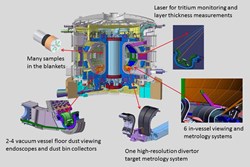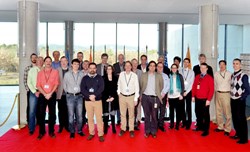ITER NEWSLINE
-
Tracking every speck of dust
Roger Reichle, Diagnostic Physicist
Tracking every speck of dust

The ITER inner chamber will be equiped with all sorts of viewing, measurement, sampling and ... vacuum cleaning systems.
From 12 to 14 February the ITER Diagnostics Division hosted a three-day workshop on erosion, deposition, dust, and tritium diagnostics which was attended by about 30 international experts. The aim of the workshop was to define the relevant suite of diagnostics that will be necessary in the ITER machine.
In ITER, the amount of dust and tritium allowed inside the vacuum vessel is limited by the technical prescriptions from the Regulator. Dust is produced either from the gradual erosion of the plasma-facing first wall elements and the re-deposition of this material inside the vacuum vessel, including some tritium, or alternately by transients, like disruptions which can produce dust in a more concentrated way.
The
decision to use tungsten instead of carbon as divertor target material has reduced the expected dust production by one to two orders of magnitude, so that the dust accumulation is expected to stay significantly below the limits. The workshop included presentations and discussions on the safety limits; newest modelling and experimental results (mainly from JET's
ITER-like wall); and the proposed diagnostics, including worldwide experience with similar systems.

Thirty international experts participated in the workshop aimed at defining the suite of erosion, deposition, dust, and tritium diagnostics that will be necessary in the ITER machine.
Measuring overall erosion, the potential source of dust, is the job attributed to the in-vessel viewing system. Dust on the vacuum vessel floor will be examined by endoscopes. Further information will be gleaned by analyzing sampling bins in which dust accumulates. Infrared viewing will allow the identification of dust and deposits on hot surfaces; laser methods will determine the thickness of deposits. Vacuum cleaning combined with mechanical cleaning using the multi purpose deployer (MPD) is an option being considered to manage the dust.
The evaluation of the physics models requires higher resolution from the diagnostics systems than necessary for assuring the conformity with the limits. For a carbon divertor it had been assumed necessary to measure even during discharges to follow the erosion of the divertor target; with a tungsten divertor, this need has disappeared, which simplifies the diagnostic designs. The main measurement for the tritium amount in the vacuum vessel is provided for by accurate accounting in the Tritium Plant. Supporting in-vessel methods include laser methods and samples.
During the workshop recommendations were also made for useful operations in the non-active phase of ITER. These recommendations include the removal of an entire divertor cassette for detailed investigation, the use of the MPD to sample dust and deposits from inside the vacuum-vessel and the conduction of some gas-fuelling experiments with careful accounting of how much of it is retained in the wall.
return to the latest published articles








